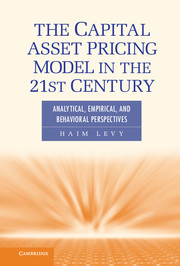 The Capital Asset Pricing Model in the 21st Century
The Capital Asset Pricing Model in the 21st Century Book contents
- Frontmatter
- Contents
- Preface
- 1 Introduction
- 2 Expected Utility Theory
- 3 Expected Utility and Investment Decision Rules
- 4 The Mean-Variance Rule (M-V Rule)
- 5 The Capital Asset Pricing Model
- 6 Extensions of the Capital Asset Pricing Model
- 7 The Capital Asset Pricing Model Cannot Be Rejected
- 8 Theoretical and Empirical Criticism of the Mean-Variance Rule
- 9 Prospect Theory and Expected Utility
- 10 Cumulative Decision Weights
- 11 The Mean-Variance Rule, the Capital Asset Pricing Model, and the Cumulative Prospect Theory
- References
- Name Index
- Subject Index
3 - Expected Utility and Investment Decision Rules
Published online by Cambridge University Press: 05 June 2012
- Frontmatter
- Contents
- Preface
- 1 Introduction
- 2 Expected Utility Theory
- 3 Expected Utility and Investment Decision Rules
- 4 The Mean-Variance Rule (M-V Rule)
- 5 The Capital Asset Pricing Model
- 6 Extensions of the Capital Asset Pricing Model
- 7 The Capital Asset Pricing Model Cannot Be Rejected
- 8 Theoretical and Empirical Criticism of the Mean-Variance Rule
- 9 Prospect Theory and Expected Utility
- 10 Cumulative Decision Weights
- 11 The Mean-Variance Rule, the Capital Asset Pricing Model, and the Cumulative Prospect Theory
- References
- Name Index
- Subject Index
Summary
Introduction
In this chapter, we discuss several stochastic dominance (SD) investment criteria, of which some are quite old and well known and some are relatively new and therefore not as widely known. As we see later in this book, we employ some of these SD investment criteria in the analysis of the Capital Asset Pricing Model (CAPM) in the Prospect Theory (PT) framework.
We discuss First-degree SD (FSD), Second-degree SD (SSD), Prospect SD (PSD), and Markowitz's SD (MSD). All these SD rules are derived in the expected utility framework. The FSD criterion is a cornerstone also in the Cumulative Prospect Theory (CPT) framework and is, in fact, imperative to all the relevant competing investment decision paradigms. Actually, to derive the FSD rule, one needs only to assume monotonicity: the more wealth one has, the better off one is. This is a reasonable assumption, and almost all economic models of decision making assume monotonicity. In terms of the utility function, this assumption implies that U′ is non-negative. Indeed, in some of the proofs of expected utility theory (EUT), the FSD requirement replaces the monotonicity axiom.
- Type
- Chapter
- Information
- The Capital Asset Pricing Model in the 21st CenturyAnalytical, Empirical, and Behavioral Perspectives, pp. 46 - 62Publisher: Cambridge University PressPrint publication year: 2011


